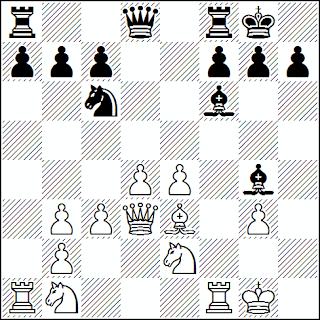Eintalu Jüri - Uibos Andre 1 - 0
It seems that my move 4. Ne2 has not been played earlier.
Formally, the present game was correspondence chess, using the site lichess.org.
We agreed not to use computer analysis during the game.
However, actually, we used this website to play a caffee chess, having an option to do other things as well during the game. Officially, one day per move, but actually we played 3 days only.
In fact, I did not use the external chessboard and only rarely looked upon the diagram.
Some mistakes are due to the trolleybus and a small screen of the mobile phone.
This game turned out to be very interesting to my mind.
For the computer analysis with my comments, see the following site:
http://lichess.org/QIwWQ0Ys"
Below, I am trying to shortly comment on this game.
1. e2-e4 e7-e5
2. f2-f4 e5xf4
3. Bf1-c4
King's Gambit, Accepted, Bishop's Gambit.
3... Bf8-e7
4. Ng1-e2!? Be7-h4?!+
The right move is 4... d5! and White has difficulties. For example:
4. exd5? Bh4+ 5 g3? (Else, what was the idea of 4. Ne2 instead of the usual 4. Nf3.) 5... Bg4!! and Black wins;
4. Bxd5 and now:
4... Bh4+!? is probably the best, but these variations are sharp and highly complicated;
4... c6 5. Bc4 b5 6. Bb3 Bh4+ 7. g3 fxg3 8. 0-0 and probably White survives with an exact play.
5. g2-g3 f4xg3
6. h2xg3 Bh4-f6
7. d2-d4 d7-d5
8. Bc4xd5 Ng8-e7
9. Bd5-b3 Ne7-c6
10. c2-c3 Bc8-g4
11. O-O O-O
Here, White should have been played 12. Qd3, letting the square e3 free for one's queen (in case of Black's move Ne5 here or later). For example, 12...Na5?! 13. Bc2.
But White wanted to secure the pawn d4...
12. Bc1-e3?! Nc6-a5!
Now, 13. Bc2 Nc4 14. Bc1 Bg5 did not seem to be good for White.
13. Qd1-d3 Na5xb3
14. a2xb3 Nb8-c6
15. Nb1-d2?
White is suffocating one's undefended queen on the square d3 — while that Queen is the only defender of the knight on the square e2.
It was better to play 15. Nf4, defending the queen d3 and removing the attacked knight e2.
15... Nc6-e5!
16. Qd3-b5 a7-a6
17. Qb5xb7 Bg4xe2
18. d4xe5?
Better was 18. Rf2.
18... Bf6xe5?!
Stronger was 18...Bg5!
19. Rf1-f2 Qd8-d3
20. Nd2-c4 Ra8-b8
21. Qb7-a7!
21... Be5xc3?!
21...f6 was sufficiently good. After 22. Nxe5 fxe5 White's bishop e3 does not have good places d4 or f4, while Black has opened the f-file for one's rook on f8.
I was prepared to analyse the continuation 21...f6 22. Qxa6 Bh5.
22. b2xc3 Rb8xb3
23. Ra1-e1 Rb3xc3
24. Rf2xe2 Qd3xc4
25. Be3-f2
Now, White has a good position.
25... Qc4-c6
26. Re2-a2 Rf8-a8
27. Qa7-d4 Qc6-c4
28. Re1-d1 Qc4xd4
29. Rd1xd4 c7-c5?
Here or later, Black had to make a move f7-f6 or h7-h6...
30. Ra2xa6! Ra8-c8
31. Rd4-d7 Rc3-c1+
32. Kg1-g2 c5-c4
33. Ra6-c6
In a practical game, it is much safer than the attack on the 7-th rank 33. Raa7.
33... Rc8-e8
34. Rd7-c7 h7-h6
35. Rc6xc4 Rc1xc4
36. Rc7xc4
Black resigns
1-0











